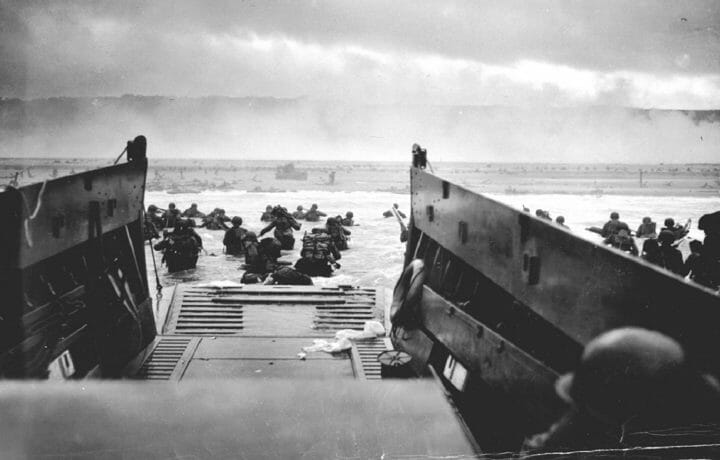Omaha Beach. Utah Beach. Pointe du Hoc. Sainte-Mère-Église. Carentan. We rightfully remember the hallowed places where American soldiers fought seventy-five years ago today, June 6, 1944. The enduring popularity of Saving Private Ryan and Band of Brothers demonstrate how deeply revered “D-Day” and “Normandy” are in our collective memory. The American sacrifices in Normandy certainly deserve commemoration. We should also take time, however, to remember that we were far from alone on those Norman beaches. An older movie – The Longest Day – may not have had Steven Spielberg and amazing special effects, but it clearly demonstrated that Operation OVERLORD (the liberation of Western Europe) and Operation NEPTUNE (the assault phase of OVERLORD) were truly coalition efforts, with substantial contributions from Great Britain and Canada.
Pinpointing the origin of D-Day is a surprisingly difficult historical exercise, but one of the best options is the Allies’ decision to appoint a Chief of Staff to the Supreme Allied Commander (COSSAC). The Allies agreed upon a COSSAC during the Casablanca Conference in January 1943, starting with designating an individual COSSAC and creating the headquarters to plan the actual invasion of the continent in 1944. The headquarters was also responsible for the deception operations, with Operation FORTITUDE obscuring where, when, and how the Allies would invade.
In December 1943, the Allies designated General Dwight D. Eisenhower as the Commander of the Supreme Headquarters, Allied Expeditionary Forces. Eisenhower’s headquarters became active in February 1944, and his immediate subordinates were all British officers: General Bernard L. Montgomery, Air Chief Marshal Trafford Leigh-Mallory, and Admiral Bertram H. Ramsay, respectively commanding Allied land, air, and sea forces. Air and maritime operations played essential preliminary roles for the invasion.
Operation Neptune: A Coalition Effort
Air Chief Marshal Leigh-Mallory directed shaping efforts that required switching Allied aircraft from strategic bombing of Nazi Germany to air bombardment of targets in Northwest Europe in January 1944. These efforts focused on transportation targets and military targets, often including efforts designed to reinforce the deception plan. Additionally, Allied aircraft and ships prevented German reconnaissance efforts, supporting the deception plan by keeping the Nazi commanders in the dark about Allied preparations.
Under Admiral Ramsay’s command, the Allies assembled a massive fleet for Operation NEPTUNE, with more than 7,000 Allied ships and landing craft. Of the warships, most were British, Canadian, and American, but there were free Dutch, French, Greek, Norwegian, and Polish as well. After Ike gave the operation the green light, the massive armada sailed south to land five Allied divisions on five separate beaches. Meanwhile, Allied aircraft dropped roughly 23,000 American, British, and Canadian paratroopers who were to hold key terrain on the flanks of the overall invasion at Sainte-Mère-Église, Carentan, and east of the Orne River, which included fighting for the now-famous Pegasus Bridge over the Caen Canal.
With General Montgomery in overall command of land forces, Allied ground troops waded ashore on five beaches. American troops landed at Omaha and Utah beaches, and Rangers scaled the 100-foot cliffs of Pointe du Hoc. The fighting for the bluffs of Omaha Beach was desperate and here the Allies suffered the largest number of casualties. Better terrain and comparatively less German resistance meant that American casualties were lighter on Utah beach. Farther east in the Allied beachhead, the British advanced on Gold and Sword as did the Canadians on Juno. All of the Allied forces were able to drive inland, outpacing German efforts to move additional troops into the area, repelling German counterattacks. From Allied wargaming, the last task fell primarily on the Canadians, who were to defeat the significant armored counterattack predicted to come in their sector.
As the five Allied divisions fought to secure their beaches and the three airborne divisions secured the flanks, Allied air attacks combined with French Resistance sabotage efforts to slow the German ability to reinforce their defenders in Normandy. The Allied navies feverishly worked to land supplies and additional forces into the beachhead while also providing essential gunfire support. There much more hard fighting ahead, but the Allies had punched through the vaunted Nazi Atlantic Wall.
A year and a half before D-Day, the “Big Four” Allies (the United States, Great Britain, the Soviet Union, and China) signed the United Nations Declaration. Before the war ended, forty-seven more nations added their names to the treaty, including thirteen who participated in the Normandy landings. These included the Free French and many governments in exile. Commemoration efforts of the 75th Anniversary of D-Day should include those coalition members who fought for Gold Beach, Juno Beach, Sword Beach, and the Orne River line alongside the Americans who liberated Omaha Beach, Utah Beach, Pointe du Hoc, Saint-Mère-Église, and Carentan. Saving Private Ryan may be the better movie, but a viewing of The Longest Day will help place events in the proper perspective.

